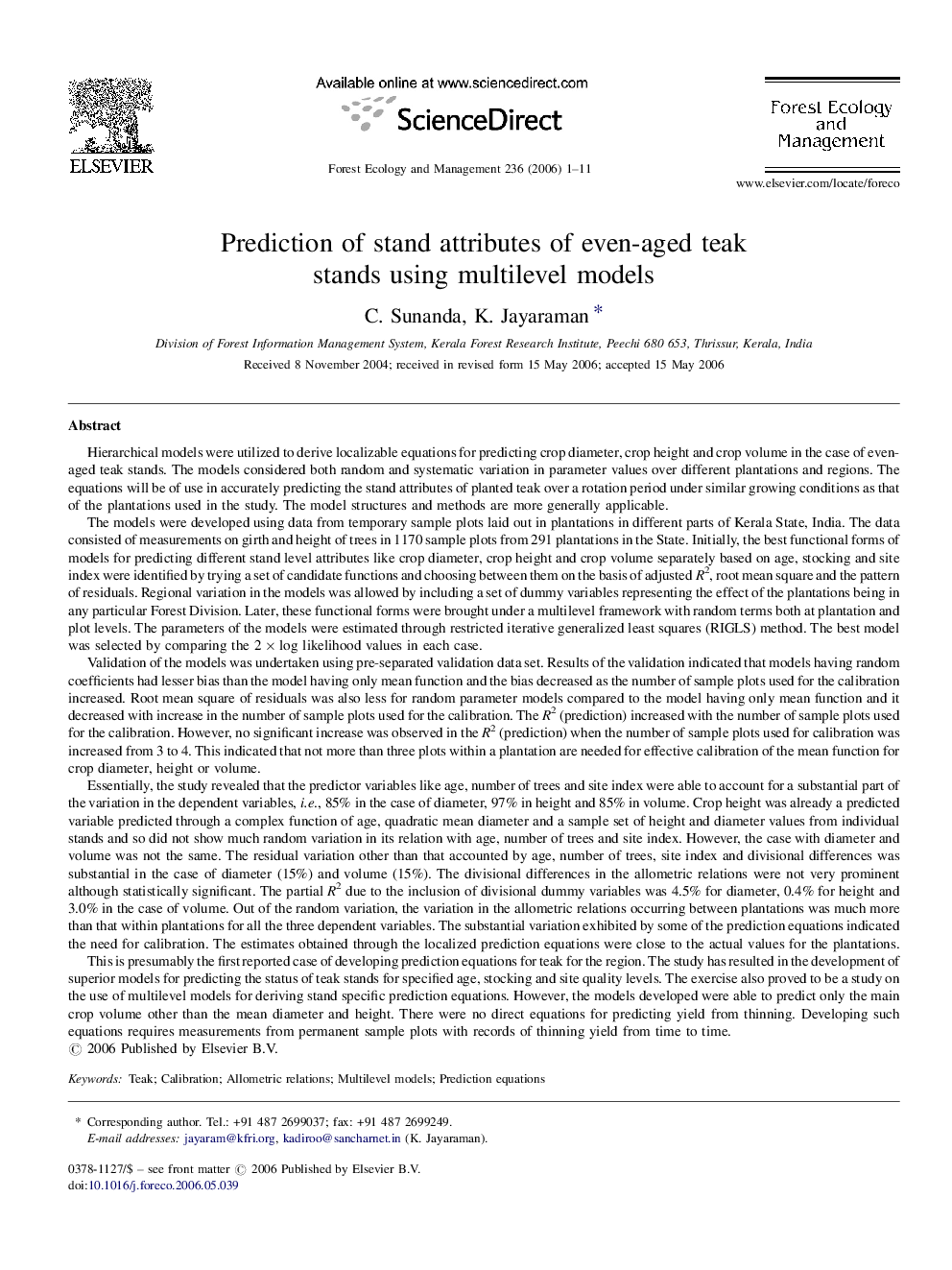| کد مقاله | کد نشریه | سال انتشار | مقاله انگلیسی | نسخه تمام متن |
|---|---|---|---|---|
| 90370 | 159377 | 2006 | 11 صفحه PDF | دانلود رایگان |

Hierarchical models were utilized to derive localizable equations for predicting crop diameter, crop height and crop volume in the case of even-aged teak stands. The models considered both random and systematic variation in parameter values over different plantations and regions. The equations will be of use in accurately predicting the stand attributes of planted teak over a rotation period under similar growing conditions as that of the plantations used in the study. The model structures and methods are more generally applicable.The models were developed using data from temporary sample plots laid out in plantations in different parts of Kerala State, India. The data consisted of measurements on girth and height of trees in 1170 sample plots from 291 plantations in the State. Initially, the best functional forms of models for predicting different stand level attributes like crop diameter, crop height and crop volume separately based on age, stocking and site index were identified by trying a set of candidate functions and choosing between them on the basis of adjusted R2, root mean square and the pattern of residuals. Regional variation in the models was allowed by including a set of dummy variables representing the effect of the plantations being in any particular Forest Division. Later, these functional forms were brought under a multilevel framework with random terms both at plantation and plot levels. The parameters of the models were estimated through restricted iterative generalized least squares (RIGLS) method. The best model was selected by comparing the 2 × log likelihood values in each case.Validation of the models was undertaken using pre-separated validation data set. Results of the validation indicated that models having random coefficients had lesser bias than the model having only mean function and the bias decreased as the number of sample plots used for the calibration increased. Root mean square of residuals was also less for random parameter models compared to the model having only mean function and it decreased with increase in the number of sample plots used for the calibration. The R2 (prediction) increased with the number of sample plots used for the calibration. However, no significant increase was observed in the R2 (prediction) when the number of sample plots used for calibration was increased from 3 to 4. This indicated that not more than three plots within a plantation are needed for effective calibration of the mean function for crop diameter, height or volume.Essentially, the study revealed that the predictor variables like age, number of trees and site index were able to account for a substantial part of the variation in the dependent variables, i.e., 85% in the case of diameter, 97% in height and 85% in volume. Crop height was already a predicted variable predicted through a complex function of age, quadratic mean diameter and a sample set of height and diameter values from individual stands and so did not show much random variation in its relation with age, number of trees and site index. However, the case with diameter and volume was not the same. The residual variation other than that accounted by age, number of trees, site index and divisional differences was substantial in the case of diameter (15%) and volume (15%). The divisional differences in the allometric relations were not very prominent although statistically significant. The partial R2 due to the inclusion of divisional dummy variables was 4.5% for diameter, 0.4% for height and 3.0% in the case of volume. Out of the random variation, the variation in the allometric relations occurring between plantations was much more than that within plantations for all the three dependent variables. The substantial variation exhibited by some of the prediction equations indicated the need for calibration. The estimates obtained through the localized prediction equations were close to the actual values for the plantations.This is presumably the first reported case of developing prediction equations for teak for the region. The study has resulted in the development of superior models for predicting the status of teak stands for specified age, stocking and site quality levels. The exercise also proved to be a study on the use of multilevel models for deriving stand specific prediction equations. However, the models developed were able to predict only the main crop volume other than the mean diameter and height. There were no direct equations for predicting yield from thinning. Developing such equations requires measurements from permanent sample plots with records of thinning yield from time to time.
Journal: Forest Ecology and Management - Volume 236, Issue 1, 15 November 2006, Pages 1–11